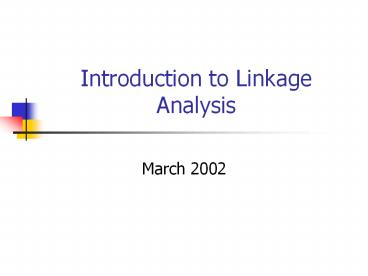Introduction to Linkage Analysis PowerPoint PPT Presentation
Title: Introduction to Linkage Analysis
1
Introduction to Linkage Analysis
- March 2002
2
3 Stages of Genetic Mapping
- Are there genes influencing this trait?
- Epidemiological studies
- Where are those genes?
- Linkage analysis
- What are those genes?
- Association analysis
3
Where are those genes?
4
Outline
- How is genetic information organized?
- Chromosomes
- Sequence
- Examples of genetic variation
- Changes that have observable effects
- Genetic markers
- Linkage analysis
- Strategy for surveying variation in families
5
Genetic Information
- Human Genome
- 22 autosomes
- X and Y
- Sequence of 3 x 109 base-pairs
- 17-20 bp can identify unique sequence in the
genome - Variation
- Most sequence is conserved across individuals
- 1 in 103 base-pairs differs between chromosomes
6
DNA
- Polymer of 4 bases
- Purines
- (A) Adenine
- (G) Guanine
- Pyrimidines
- (C) Cytosine
- (T) Thymine
- Double Helix
- Complementary Strands
- Hydrogen Bonds
7
Some Types of DNA Sequence
- Genes
- 30,000 in humans
- Exons, translated into protein
- Introns, transcribed into RNA, but not protein
- Promoters
- Enhancers
- Repeat DNA
- Pseudogenes
8
Genetic Code
- DNA ? RNA ? Protein
- DNA 4 bases (A,T,C,G)
- RNA 4 bases (A,U,C,G)
- Proteins 20 amino-acids
- Universal Genetic Code
- Translation between DNA/RNA and protein
- Three bases code for one amino-acid
9
Genetic Code
10
Example of CFTR Variants
11
Phenotype vs. Genotype
- Genotype
- Underlying genetic constitution
- Phenotype
- Observed manifestation of a genotype
- Different changes within CFTR all lead to cystic
fibrosis phenotype
12
Common types of DNA variants
- Tandem repeats
- Microsatellites
- Single nucleotide polymorphisms
- Insertions
- Deletions
13
Repeat Length Polymorphisms
- Variable Number Tandem Repeats
- VNTRs
- Typical repeat units of 10 100s bp
- E.g. 110 bp repeat in IL1RN gene
- Microsatellites
- Simple repeat sequences
- Most popular are 2, 3 or 4 bp
- E.g. ACACACAC
- D naming scheme (e.g., D2S160)
14
Microsatellites
- Most popular markers for linkage analysis
- Large number of alleles (10 is common)
- Can distinguish and track individual chromosomes
in families - Relatively abundant
- 15,000 mapped loci
15
SNPs
- Single Nucleotide Polymorphisms
- Change one nucleotide
- Insert
- Delete
- Replace it with a different nucleotide
- Many have no phenotypic effect
- Some can disrupt or affect gene function
16
A little more on SNPs
- Most SNPs have only two alleles
- Easy to automate their scoring
- Becoming extremely popular
- Typing Methods
- Sequencing
- Restriction Site
- Hybridization
17
Classifying Genotypes
- Each individual carries two alleles
- If there are n alternative alleles
- there will be n (n 1) / 2 possible genotypes
- 3 possible genotypes for SNPs, typically more for
microsatellites and VNTRs - Homozygotes
- The two alleles are the same
- Heterozygotes
- The two alleles are different
18
Genes in an individual
- Sexual reproduction
- One copy inherited from father
- One copy inherited from mother
- Each individual has
- 2 copies of each chromosome
- 2 copies of each gene
- These copies may be similar or different
19
Meiosis
- Leads to formation of haploid gametes from
diploid cells - Assortment of genetic loci
- Recombination or crossover
20
What happens in meiosis
21
Recombination
1-?
?
22
Recombination
- Actual
- No. of recombinants between two locations
- An average of one per Morgan
- Observed
- Usually, only odd / even number of crossovers
between two locations can be established
23
Recombination and Map Distance
24
Intuition for Linkage Analysis
- Millions of variations that could be responsible
for disease - Impractical to investigate individually
- Within families, they organized into limited
number of haplotypes - Sample modest number of markers to determine
whether each stretch of chromosome is shared
25
Tracing Chromosomes
26
Tracing Chromosomes
3
1
2
4
5
6
1
1
2
1
4
3
3
3
5
3
5
1
27
IBD
- At each location, try to establish whether
siblings (or twins) share 0, 1 or 2 chromosomes - Inference may be probabilistic
28
Example of Scoring IBD
- Parental genotypes are available
- Siblings are IBD 2
- Share maternal and paternal chromosomes
29
Example of Scoring IBD II
- Parental genotypes unavailable
- IBD between siblings may be 0, 1 or 2
- Likelihood of each outcome depends on frequency
of allele A
30
Example of IBD scoring III
- Looking at multiple consecutive markers helps
infer IBD - Especially without parental genotypes
- IBD 2 may be quite likely
31
Notation
- ? - IBD sharing (0, ½ and 1)
- Z0 - probability ? 0
- Z1 - probability ? ½
- Z2 - probability ? 1
32
Typical IBD information
33
Model
34
No Linkage
35
Linkage
36
Hypothesis
- Test evidence for linked genetic effect
- Fit two models
- Full model (Q,A,C,E)
- Restricted model (A,C,E)
- Maximum likelihood test
- Compare likelihoods using ?²
37
Analysis
- Estimate ? along chromosome
- For example, using Genehunter or Merlin
- Test hypothesis at each location
- Summarize results in linkage curve
- Chi-squared is 5050 mixture of 1 df and point
mass zero
38
Lod scores
- Often, report results as lod scores
- Genome is large, many locations tested
- Threshold for significance is usually LOD gt 3
39
Sample Linkage Curve
LOD

